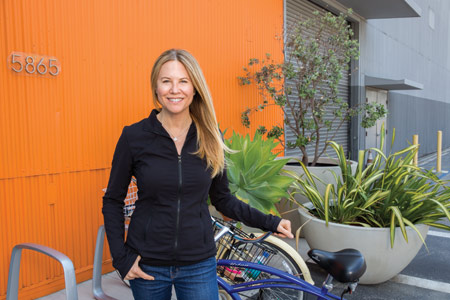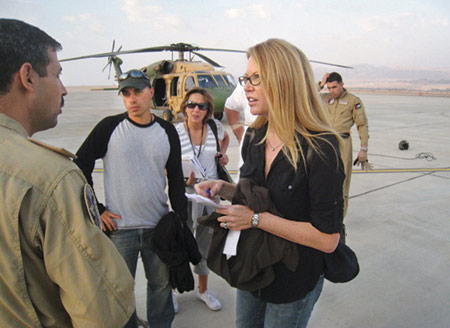By DAVID GEFFNER
 UPM Allegra Clegg
UPM Allegra Clegg One of the most interesting aspects of this job is also one of its biggest challenges,” says Los Angeles-based UPM Allegra Clegg, whose credits include all four entries in the Transformers franchise, The Amazing Spiderman (2012), and Unstoppable (2010). The essence of the job, she says, is, “How do I incorporate the diverse and specific needs of the production with those of the host city, location, government agency or corporate entity?”
She was certainly well-trained to think big. “I worked as [producer] Jon Davison’s assistant on RoboCop (1987) for two years and I felt like that was my film school. It was just Jon and I for a long time working through a lengthy preproduction period—finding the director, casting the lead, creating that suit. After it was over Jon asked me what I wanted to do next, and I said I wanted to be a production coordinator, which I did for about six to eight films on smaller budgeted movies.” Seeking more responsibility and control, Clegg jumped directly to production-managing in what she calls “an unusual career move.”
She worked on two projects with director Rob Reiner; The American President (1995) and Ghosts of Mississippi (1996), the latter of which would have a profound effect on her. “On Ghosts of Mississippi, we not only filmed at slain civil rights leader Medgar Evers’ house, we also shot at the actual courthouse in Hinds County where convicted gunman Byron De La Beckwith was kept from 1994 until his death in 2001,”
Clegg recalls. “He was there when we filmed; his cell window was in plain view from our set.”
But “the highlight and privilege of working on that production was meeting Mrs. Myrlie Evers,” continues Clegg. “When we shot the scene in which Mr. Evers is gunned down in his driveway, it was the very driveway where the crime occurred, and it impacted the entire cast and crew deeply. It was an incredibly emotional and indelible experience for everyone involved.”
Clegg tackled a completely different kind of ghost on Brad Silberling’s City of Angels (1998). “Several scenes required dialogue between two spirits unconstrained by the physical boundaries and dangers that face human beings,” she remembers. “The script called for these ghosts, embodied by Nicolas Cage and Andre Braugher, to chat on the unfinished girders of a skyscraper. We built the framing and hoisted it on top of a building in downtown L.A. The result was a remarkable feat of engineering, construction and visual effects. It proved to me there is almost nothing we can’t accomplish when you put the right creative team together.”
 TOUGH SPOT: When a Jordanian pilot balked at helicoptering the crew to the Monastery of Petra on Transformers 4, Clegg stepped in and arranged for the necessary clearance.
TOUGH SPOT: When a Jordanian pilot balked at helicoptering the crew to the Monastery of Petra on Transformers 4, Clegg stepped in and arranged for the necessary clearance. Clegg would eventually join Transformers producer (and big‑budget VFX specialist) Ian Bryce on what has now become a five‑movie partnership. For Transformers (2007) and Transformers: Revenge of the Fallen (2009), Clegg sat down with a four-star general to ask for use of three military bases and a flight squadron. For Transformers: Dark of the Moon (2011), she asked the director of NASA to allow the film to shoot around the Shuttle Atlantis as it was being prepped for final launch.
“The logistics of these types of movies are so vast,” Clegg explains. “[Transformers director] Michael Bay works very fast and likes effects done in real locations. Something like the wingsuit flyers sequence for Transformers 3 in Chicago, which had never been done before, required months of coordination.”
Clegg’s team arranged with then-Mayor Richard Daley’s office to secure a three-day closure of Chicago’s busiest thoroughfare during peak tourist season. “The stunt guys base-jumped off the Willis Tower [formerly Sears Tower], which was open for business the entire time,” she recalls. “We had 1,000 people on payroll—police, fire, traffic—helping to ‘sterilize’ designated areas, so that if, God forbid, something went wrong, public safety would not be impacted. And nothing did.”
Safety, Clegg insists, is the most important consideration on Bay’s ambitious movies. “The key is hiring people who are not afraid to say ‘stop,’ no matter how much pressure there is to keep the set moving. “The wingsuit flyers would not jump until the wind was favorable and I absolutely had to respect their expertise.”
Clegg also had to weather socio-cultural winds while shooting Transformers 2 in the Middle East. Permits to film on the streets of Cairo were revoked the night before a shoot day, and filming at the Great Pyramids and Temple of Karnak was only possible with the direct approval of Egypt’s Minister of Antiquities.
Shooting in Jordan, where Bay wanted to raise a massive 80-foot camera crane on The Monastery, a mountain in the ancient (and archaeologically sensitive) city of Petra with 1,000 steps only accessed by foot or mule—yet another movie industry first—went more smoothly.
“Jordan is run by a king, and the Chairman of the Royal Film Commission, Prince Ali Bin Al-Hussein, is his brother,” laughs Clegg. “So is it a bit surreal asking a prince, and a White House insider, for four military helicopters? Definitely. But it’s also really fun.”
Clegg, whose mother was a ballerina and respected ballet teacher, has a natural grace for complex human interactions; her sunny demeanor belies a keen negotiating sense.
“I love it,” Clegg smiles. “Even if you don’t always get your way—like Middle East governments not allowing you to show locations with poverty or decay—[the goal of bargaining] is to get many different kinds of people to understand [the film] business and create a solid partnership. There’s no way we could do this alone.”